| Harmful Algal Bloom Photos |
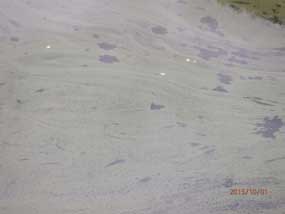 |
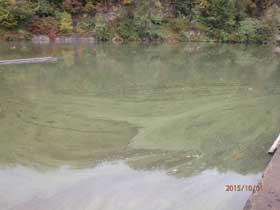 |
| HAB: Cyanobacteria bloom in R.D. Bailey Lake, WV in 2015. While this bloom was dominated by a non-toxin producing species of Lyngbya, potential toxin-producing Pseudanbaena was also present. |
| |
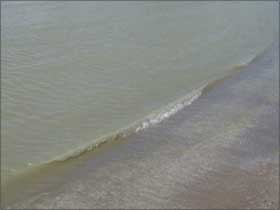 |
|
| HAB: Cyanobacteria bloom at Maumee Bay State Park, OH in 2011. Note the lack of surface scum. Microcystin concentrations were greater than 100 µg/L at this location. |
| |
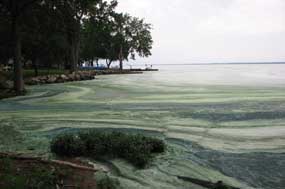 |
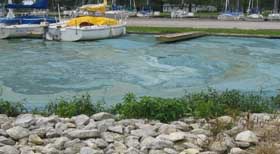
|
| HAB: Cyanobacteria bloom in Grand Lake St. Marys. OH in 2010 |
| |
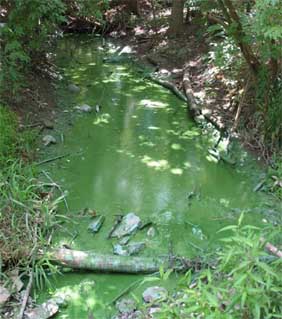 |
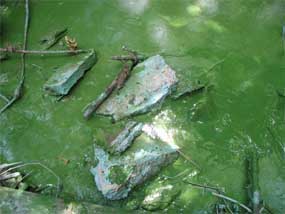 |
| HAB: Cyanobacteria bloom in a tributary to Muddy Creek, Warren County, OH in 2009. Note the blue pigment on the substrate from the dried/dead cyanobacteria. |
| |
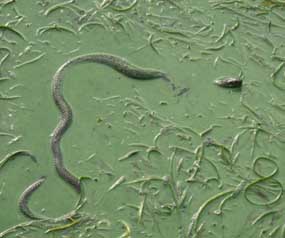 |
 |
| HAB: Cyanobacteria bloom in Lake Erie in 2011. Microcystin levels in the Western Basin of Lake Erie were greater than 1000 µg/L. |
|
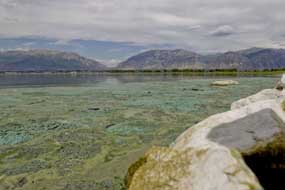
|
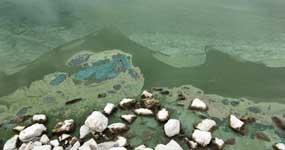 |
| HAB: Microcystis, Dolichospermum, and Aphanizomenon bloom in Utah Lake in July 2016. This bloom reappeared in July 2017 and both Microcystins and anatoxin-a were detected.
|
| |
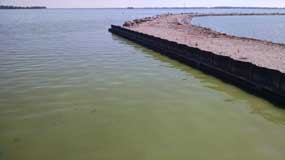
|
|
| HAB: Planktothrix bloom at the Celina intake on Grand Lake Saint Mary, OH in September 2015. Note the lack of surface scum. Planktothrix blooms do not typically form scums. Microcystin concentrations were 185 µg/L. |
| |
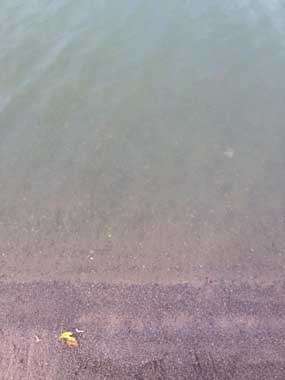
|
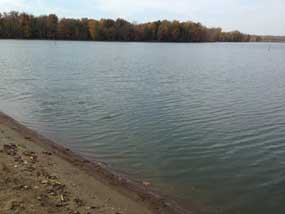
|
|
HAB: phanizomenon
and Planktothrix bloom on Chippewa Lake, OH in November 2016. Note the lack
of surface scum. Microcystin concentrations were between 48 and 58 µg/L. |
| |
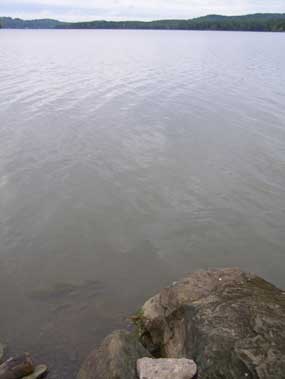
|
 |
| HAB: Cylindrospermopsis dominated bloom in OH. Note the lack of scum and turbid look of the water. |
| |
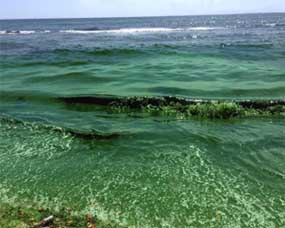
|
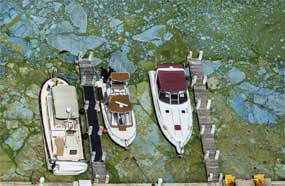 |
| HAB: Harmful Algal Bloom on Lake Okeechobee, FL in 2016. Microcystin concentrations were 17.6 µg/L. Saxitoxins were also detected with this bloom. |
|
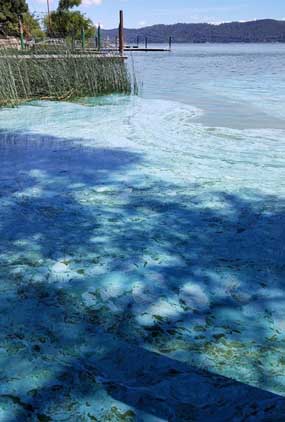
|
|
| HAB: Harmful Algal Bloom on Clear Lake, CA in 2013. Microcystin concentrations were 17,000 µg/L. |
| |

|
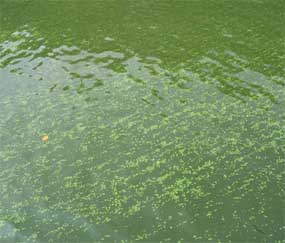 |
| HAB: Microcystis bloom on the Ohio River in August 2008. |
| |

|
|
| HAB: Planktothrix rubescens bloom in Apple Valley Lake, OH in December 2011. Planktothrix rubescens is a benthic cyanobacteria, meaning it grows on the bottom of the lake/river.Planktothrix rubescens blooms typically appear at the surface of lakes, as a red scum, after fall turnover events. These blooms may be present at the bottom, producing cyanotoxins, with no surface indicators. |
| |
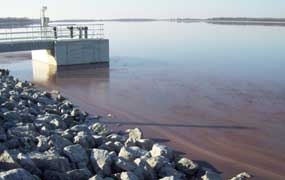
|
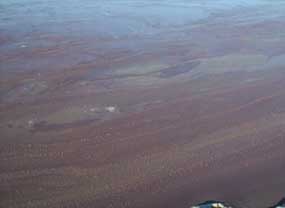 |
| HAB: Planktothrix rubescens bloom on Williams Reservoir, OH in November 2015. Microcystin concentrations were 1,400 µg/L. Planktothrix
rubescens is a benthic cyanobacteria, meaning it grows on the bottom of the lake/river. Planktothrix rubescens blooms typically appear at the surface of lakes, as a red scum, after fall turnover events. These blooms may be present at the bottom, producing cyanotoxins, with no surface indicators. |
| |
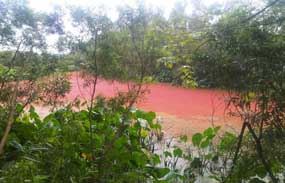
|
 |
| HAB: This is a non-cyanobacteria Harmful Algal Bloom caused by Euglena sanguinea in Dillon Lake, OH on July 20, 2012. Euglena sanguinea can produce euglenophycin, a toxin whose chemical structure is similar to fire ant venom and may pose human health concerns. |
| |
| Non-Harmful Algal Bloom Photos |
 |
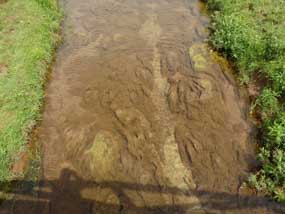 |
| Non-HAB: Overgrowth of native waterweed (Elodea sp.) and filamentous algae in Bonds Creek in May 2017. |
| |

|
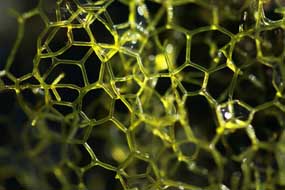
|
| Non-HAB: Hydrodictyon is a type of green algae with a pentagonal or hexagonal mesh-like structure. Hydrodictyon does not produce cyanotoxins. |
| |
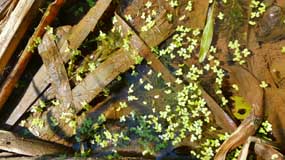 |
|
| Non-HAB: Duckweed (Lemna sp.) is a native flowering plant and is not capable of producing toxins. |
| |
| Cyanobacteria Micrographs |
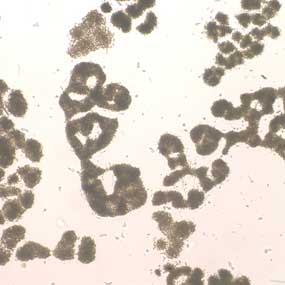 |
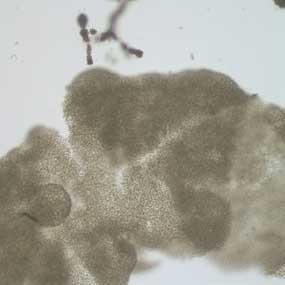 |
Microcystis - Spherical cells are often densely, and irregulary, arranged into colonies.
Blooms look like: bright blue-green clumps dispersed throughout the water column and may develop into large surface scums.
Potential toxins: Microcystins |
| |
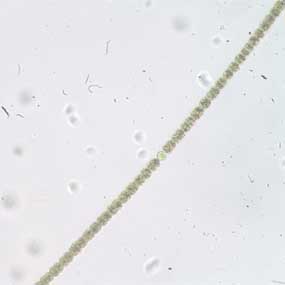
|
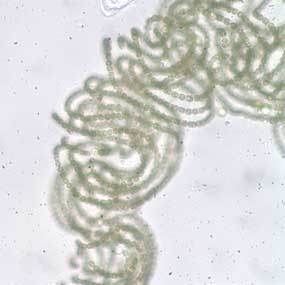 |
Dolichospermum (formerly Anabaena) - The spherical or barrel-shaped cells are filamentous and may be straight or coiled.
Blooms look like: bright blue-green surface scums.
Potential Toxins: Anatoxin-a, Cylindospermopsin, Microcystins, Saxitoxin |
| |
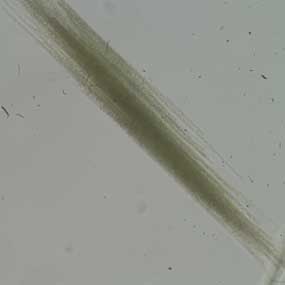
|
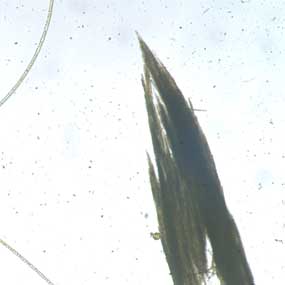 |
Aphanizomenon - Cells are usually cylindrical and form filaments with tapered ends.
Blooms look like: bright blue-green threads that resemble grass clippings or spilled paint.
Potential Toxins: Anatoxin-a, Clyindrospermopsin, Saxitoxin, Microcystins |
| |

|
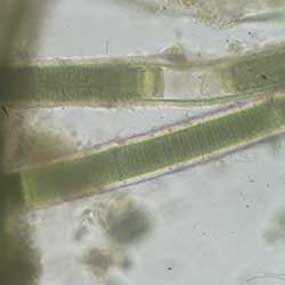 |
Lyngbya - Cells are wider than they are long and form filaments with sheaths extending beyond rounded ends.
Blooms look like: With tidal action, can form dense balls of filaments. Do not typically form surface scums; often found with other HAB species.
Potential Toxins: Debromoaplysiatoxin, Lyngbyatoxin-a, Cylindrospermopsin, Saxitoxin |
| |
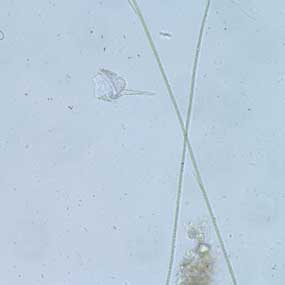 |
 |
Planktothrix - Cells are cylindrical and are slightly wider than long and form filaments with rounded ends (no sheath present).
Blooms look like: Red to purple scum
Potential Toxins: Anatoxin-a, Saxitoxin, Microcystins, Lyngbyatoxin-a |